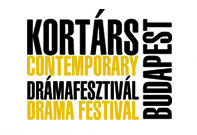Krisztián Gergye Company:
MU Theatre, 27th and 28th November 8.00 PM
– contemporary puppet-dance-theatre –

photo: Dusa Gábor
Main player – puppeteer: Marica Tárnok
Other players: Nikoletta Gresó and the puppets
Costumes: Móni Béres
Make-up, masks: Balázs Károlyi
Production assistant: Dóra Trifonov
Dramaturge: Melánia Miklós
Choreography: Krisztián Gergye
Choreographer, director: Krisztián Gergye, Marica Tárnok
In the all-artistic performance GAIA an archaic image comes alive, a personal myth of creation, a ritual of presence, a theatre of confession, a round dance, a danse macabre, a circus attraction, a stand-up comedy, a sit-down tragedy, a peepshow, a dance show. It’s an ironic play and an evening of grotesque humour seasoned with the life symptoms of our era, its gestures, clichés and idiosyncracies.
„An enraged goddess, a grotesque comedienne, a female story-teller, a puppeteer (as always), a vain, loose woman, a despotic adult and a curious child, a sexless, numbing nightmare and a seductive giantess: Marica Tárnok masterfully slips from one skin into another, from one role into another. But there is no tale to tell: we find out from her that the tale has been lost/stolen. So, could all this be a kind of substitute? A tale-replacement? We have in front of us the pictures of the „what if“, of lonely fantasies in the heart of a room, of frivolous provocation, of boldness and of a psychological condition beyond it (. . .)
In Gaia the pleasures and the burden of the flesh, the body appear as masks, and the play presents the loneliness of the puppeteer, the dreams woven about herself and her hidden life stories: after a while we look at Marica Tárnok’s voluptuous, trembling figure as if it were a costume itself. Her big, cushioned body is often the source of risky humour (. . . ) The playbill tells us to enjoy the performance and so we do: Marica Tárnok is a genuine comedienne (. . .) If needed, she imagines herself in a sideshow: she’s being malicious and provocative with the help of (black) humour. If needed, she „sheds“ her skin, the bulky cushions (which at times come to life with astonishing playfulness) off her body. She stands before us wearing a pair of net-stockings, underwear and a bra, and she relentlessly and with huge strength steers our attention from her exposed figure to her face and to her spoken words.“ (Tamás Halász, SZÍNHÁZ)
Supported by: OKM

















